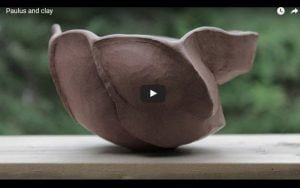Preparing to throw a plate on the pottery wheel.
When it comes to throwing a plate on a pottery wheel, there are a few good practices you should go through before you actually start throwing:
Plan out your plate.
The first is deciding how big you want your plate to be. This will help decide the amount of clay that you use for your plate. The average amount of clay to use in a plate is approximately two pounds, or a little bit more if you struggle with keeping your pieces thick. This extra clay also helps with keeping your plate thick enough to prevent you from trimming straight through the foot ring later on.
Remember you can always trim away excess clay, and that it is harder to add on clay to a plate once it is thrown.
Wedge your clay.
The second point to consider is wedging all of your clay before you sit down to throw. This makes it more fluid for when you want to throw so you don’t have to get up after you throw one piece, wedge, and then go back to throwing.
Use the same amount of clay.
The third and final concept is to use the exact same amount of clay if you are throwing multiple pieces that you want to be very similar. Having same amount of material to start can help you replicate pieces with greater ease. We recommend using a weighing scale like this one.
Throwing a Plate in Four Easy Steps
So now that you are prepared to start, with your balls of wedged clay, lets get on to how you throw a plate on the wheel.
Step 1 – Centering the Clay & Opening
The beginning of throwing a plate starts with placing your clay on the wheel and then centering it. The techniques to throw a plate are similar to throwing a bowl, vase, or mug. However, there are a couple of aspects that are distinctly different and important to remember. When you are centering your clay to create a plate it is important to go wide and low instead of thin and tall. Once you have a form that is wider and lower than what you would do for a vase or mug, for example, then it is time to open up the form slowly similar to how you would open up a bowl. Going at a 45-degree angle for your plate is a good idea to get a gentle slope on the inside for your plate in the beginning.
Step 2 – Compressing the plate
Once the form is opened to a similar width as a bowl, it is time to compress the lip down and outwards to create the plate shape. Remember to avoid pulling the lip up and outwards over your form before you compress the lip, as this will trap sludge and air beneath the plate edge. The most important part of throwing a plate is compressing the middle of the plate to prevent cracks from occurring in the future. If you have a hard time estimating by sight, you can use a needle tool to check the thickness of the plate as long as you compress it back down afterwards. The recommended thickness of a plate is around 1 centimeter or so. You can go thinner, but remember it is often easier to simply trim away the excess later on. If you need to thin out your plate first compress down with your hands and sponge, and then slowly pull the clay outwards towards yourself. Remember to leave some extra clay around the rim of the plate so that you can pull it out. This creates a defined section between the rim and the floor. Keeping the rim a bit thicker prevents it from flopping while being thrown and also prevents chipping later in the bisqued or glazed stage.
Step 3 – Forming the Rim
Be sure to have a level and smooth surface for your plate as it will most likely be used to consume food. You can also create a gentle slope to the middle if you want to have liquids stay more in the center than the sides. Now that the rest of the plate is all cleaned up it is time to form the rim. Using the extra clay that you left at the edges earlier, you pull up and outwards gently. Supporting the underside of the rim is a good idea to make sure everything stays symmetrical and will not flop. Be sure to not overwork the clay or the rim will flop – this is also known as drooping over. The style of your rim depends on the plate that you want to create, but in general, it’s a good idea to keep the plate deep and the rim tall so that when someone is using it the rim will prevent the food from flying out. Before you are finished with throwing a plate remember to gently finish the rim with a sponge or cloth. This will create a smooth and rounded edge which is best for preventing chipping down the road.
Step 4 – Cutting the Plate off the pottery bat
Finally, you are done throwing a plate! Use a wire tool and cut it off the pottery bat, but remember to leave it on the bat until the rim is leather hard. Then gently place another bat on top of the rim, like a bat sandwich, with your plate being in the middle. Then you can flip the sandwich over so that the plate is rim down, and can take the bat off gently from the bottom of the plate. This technique will allow an easier time for getting the plate off the bat, trimming, and drying your plate out when it is done.
To see a step by step video of how to easily throw a plate, check out the video below!
Conclusion:
- Plan your plate’s size.
- Wedge your clay and make a set of even balls to throw.
- Throw to a 45-degree angle.
- Compress the base to around 1 cm thickness.
- Pull up and outwards – supporting the underside.






Responses